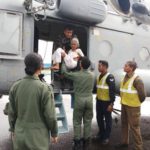Since Wednesday, the IAF has flown scores of sorties, hoisting more than 314 forlorn civilians from inundated neighbourhoods to relatively high-ground.
The whirr of the twin turbine engines of the Russian-made Mi-7 helicopter of the Indian Air Force (IAF) is perhaps the best sound that persons stranded on roof-tops in flood-hit districts of Kerala can hope for.
Since Wednesday, the IAF has flown scores of sorties, hoisting more than 314 forlorn civilians from inundated neighbourhoods to relatively high-ground.
INS Garuda, the naval air station in Kochi, is the staging point for the ongoing air rescue effort code-named “Operation Karuna”.
The IAF station at Shangumugham here is the transit airbase for the forward supply of relief material, rescue equipment and defence personnel to Kochi.
A senior official privy to the massive air rescue campaign said the operation had its own set of unique hazards, explaining why in at least a few cases the copters had to turn away from rescuing marooned citizens at the last minute.
For instance, in Aluva and Eloor, the pilots found that many houses had their terraces partially or entirely roofed over with aluminium sheets.
They reckoned that the powerful downwash of their machines could uproot the flimsy structures and potentially endanger the aircraft and persons waiting on the ground to be saved.
In some cases, pilots reported to base that tiles, hoardings and tree branches got dislodged when they flew in close for the rescue.
The officer said the IAF pilots also took a tremendous risk when they operated and hovered below maximum operational height to winch-up marooned citizens. He said that at low levels the pilots invariably lost most visual references and flew by instinct and experience alone. Typically, when helicopters navigated around buildings, trees and power-lines, they inadvertently diminished the window to execute a fast fly-away in the event of a snag.
The risk of the rotors striking obstacles such as power lines or trees was perilously high at low attitudes, he said. Another officer said that over Kochi, adverse winds and pounding rain continually tested the courage and expertise of IAF pilots as they flew sortie after rescue sortie. “The IAF pilots pushed themselves far beyond normal flying limits”, he said.
The ground staff at INS Garuda worked like “pit crews” on formula racing circuits. They worked as if it was a “war situation”, he said. Ground crew teams refuelled the machines and made mechanical adjustments and executed repairs in a jiffy, thus drastically reducing the turn-around time of the rescue helicopters.
Men from the special forces unit of the Indian Air Force, the Garud commandos, flew on board the helicopters with Army specialists for rescue missions. They abseiled down the copters to reach stranded persons, whom they helped hoist up using high powered winches.
Another officer said the operations were hazardous and anything could go wrong. “The person who is rescued could panic and dislodge the harness. Commandos advise citizens not to look down and close their eyes as they are winched up”.
The wind could shift drastically, and the hoisting cable could get strained or caught on power-lines, tree branches or even clotheslines and dislodged roofing”, he said.
On the ground in Ernakulam, Chenganoor, Kolenchery and Pathanamthitta, the 13 Garwhal Rifles, who are spearheading rescue operation “Sahyog”, faced a different set of difficulties.
A senior officer said submerged vehicles on flooded driveways, gates of houses, uprooted trees, litter, discarded plastic bottles and bags and other flotsam became obstacles that took time and hard labour to surmount. The combat units used entrenching tools and braved neck-high water and strong current to break open gates in many residential areas to rescue citizens.
They fashioned gangplanks from available material to help citizens perched on rooftops to step-off safely. They created “towpaths.” using stout ropes to haul citizens to dry ground on rescue boats.
In Ernakulam, the propellors of motorised boats commandeered by Army snagged on submerged roots and other detritus, including discarded plastic bags. Soldiers then had to row on paddle boats to search and rescue marooned people.


Leave a Reply